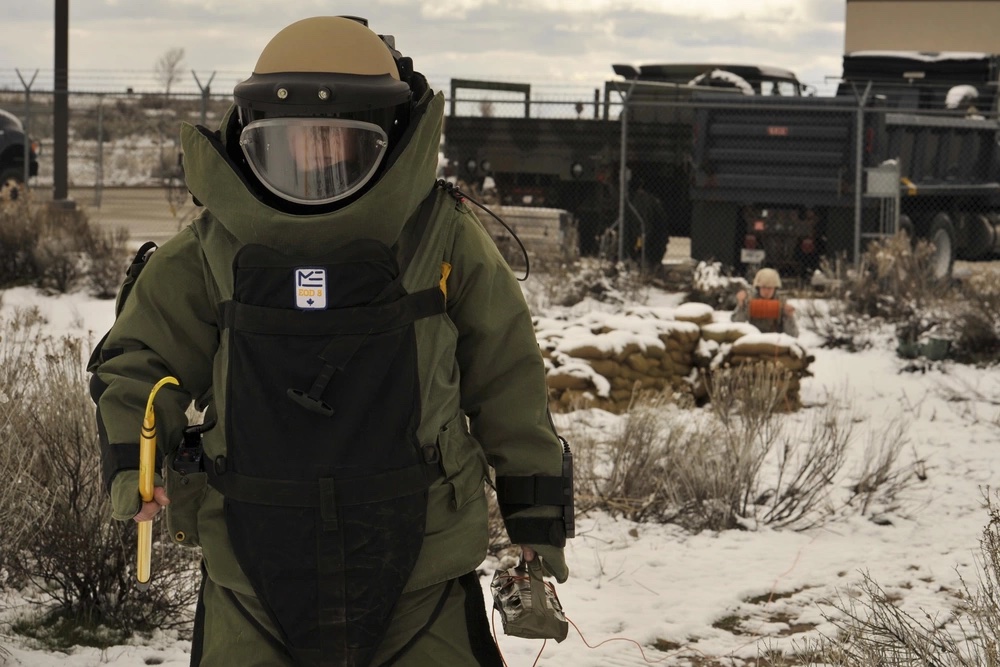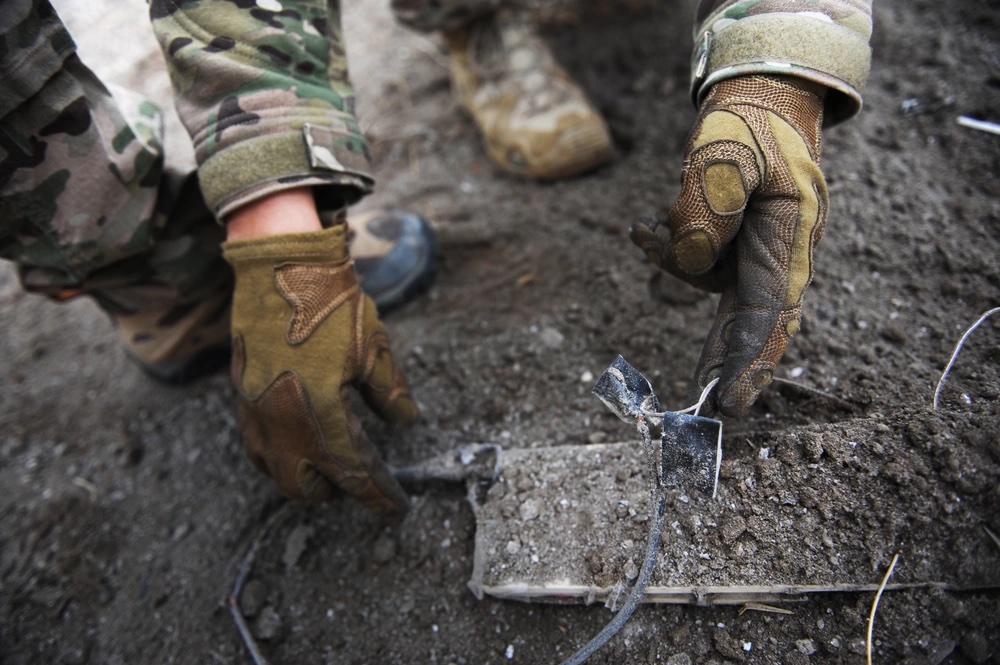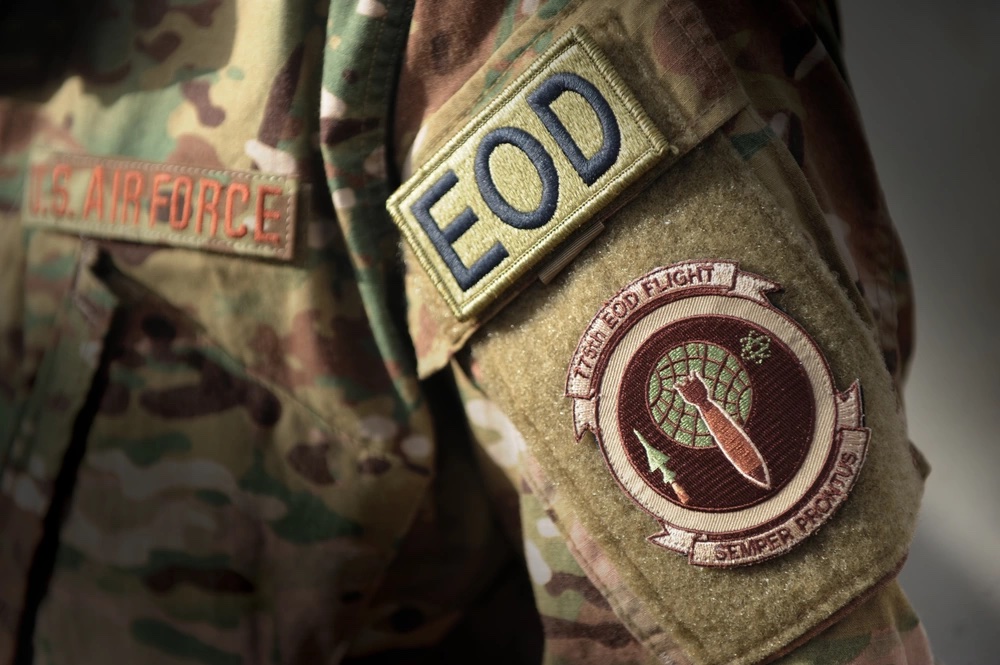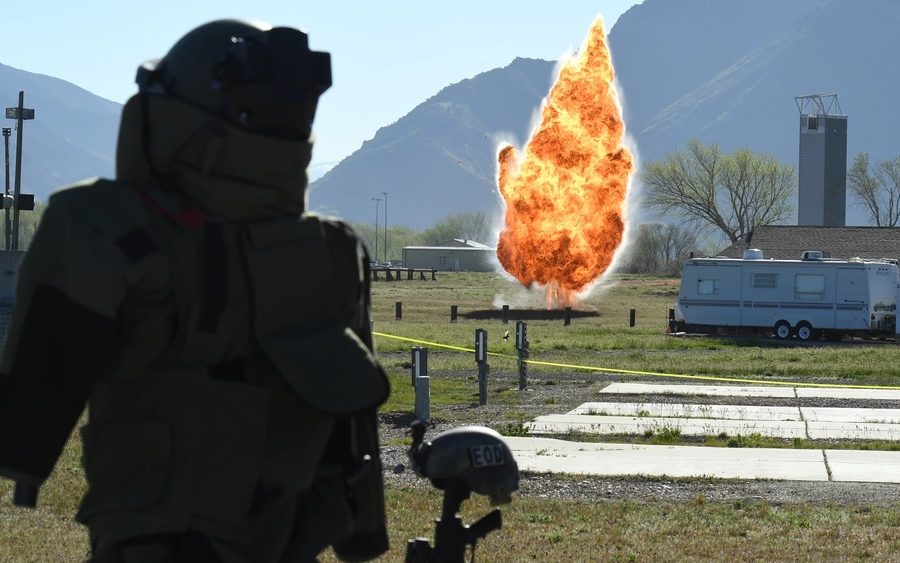HILL AIR FORCE BASE, Utah—Over the past 20 years, military explosive ordnance disposal (EOD) technicians have become very good at using high-tech tools like robots, communications jammers, smartphones, and next-generation bomb suits to disable improvised explosive devices (IEDs) in crowded urban environments.
When it comes to a possible conflict with a near-peer adversary like China or Russia, though, EOD techs are preparing for different environments, faster timelines, less sophisticated tools, and more explosives. And to meet that challenge, they’re turning to “old-school World War II tactics,” Airmen told Air & Space Forces Magazine.
During the Global War on Terror, troops often had to secure a city block against ground attack so that bomb techs could safely defuse a single IED. In the future, Air Force EOD techs may have to clear isolated runways of large numbers of air-dropped unexploded ordnance as quickly as possible before another air attack arrives.
“We’re worried about ‘how do I clear this runway fast using the least amount of stuff,’ because it’s going to happen again,” said Staff Sgt. Cody Patterson, a member of the 775th Explosive Ordnance Disposal Flight at Hill Air Force Base.
“We are boiling down to old-school World War II tactics where we use rope, tape, and zip ties to pull submunitions off a runway all at once,” he added. “Or, if one’s available, we can fill a backhoe bucket full of concrete, drop it down, and push them off. You’re trying to be quick; the longer our planes are sitting on the tarmac, the longer they are a target.”

In a future fight against the likes of China, the Air Force’s Agile Combat Employment concept calls for dispersing Airmen and aircraft to smaller, more austere bases in order to complicate an adversary’s targeting.
But those bases won’t be immune from attack. In particular, planners worry that an adversary would drop submunitions across an airfield. Submunitions are small explosives that may be distributed over a wide area. Not all of those submunitions detonate on impact, so they pose a lingering threat to military operations such as running an airfield.
In such a scenario, EOD techs would face new challenges given the nature of those small, austere, remote bases.
“How is an EOD unit with fewer tools, less manning, fewer explosives and potentially spoofed radios on an island in the middle of nowhere going to be able to recover that runway?” Patterson said. “It is going to come down to thinking outside the box, figuring out a way to clear those out so that we can launch aircraft.”
Clearing a runway of submunitions in the middle of a near-peer fight may look relatively Stone-Aged. The old-school but effective techniques include shooting the fuse off a bomb with a .50 caliber slug or using a “tape-and-line,” where EOD techs use tape, rope, and a wrench to pull the fuse out of a bomb from a distance.
“The whole idea is to use a rope that’s extremely long, usually about 1,000 feet for a 500-pound bomb,” Patterson explained. “That technique is from the 1940s and we still test that in EOD to this day.”

In a future fight, the Air Force may not be able to fly a 700-pound robot to an island in the middle of the Pacific, but EOD techs are accustomed to working with what they have on hand.
“What we are used to operating out of, if you can give us one Humvee or a solid truck, we’re going to be able to hammer out every mission,” said Patterson, who cautioned that more equipment may be required when chemical or biological weapons are involved.
The 775th EOD Flight in particular gets plenty of practice disabling submunitions on the Utah Test and Training Range, an area about the size of Delaware where military aircraft practice dropping a wide range of ordnance. Not all of those weapons detonate on impact, which can pose a hazard to range workers or scientists trying to collect data on weapons tests, so EOD steps in to finish the job.
Part of the challenge of a possible near-peer fight is that EOD technicians may be the first ones to see some of the enemy’s ordnance up close.
“I know that they are going to drop submunitions and I know that, most likely, I am not going to know what they are,” Patterson said. “A small piece of what we’ll have to do is exploit the first one we run into, get all the technical data, figure out how it works, pass that on to our buddies and push them off the runway.”
There is also the possibility Russia or China may use IEDs as well as conventional ordnance. U.S. troops will also likely keep facing IEDs during operations in eastern Africa or the Middle East.
“It is never going to go away, but we try to treat everything similar, whether it is an IED, an [unexploded ordnance], or a WMD,” Patterson said. “We want to command and control the situation because we are the technical experts.”

Patterson emphasized that defusing explosives would not be Air Force EOD’s sole contribution to a near-peer fight. As experts in explosives, EOD technicians are frequently consulted by other service members in the process of building air bases and deciding how and where to place hardened aircraft shelters (HAS).
“They will turn to an EOD expert and ask ‘Hey, I want to put a plane in this HAS, what happens if a bomb hits the outside of it? Where should we put our common and control station? Do you think this is enough dirt to stop a bomb?’ That sort of thing,” Patterson explained. “We’re integral in the planning phase to protect assets.”
Standing up an air base or restarting it after an attack may also see EOD pick up unusual new roles. As part of its shift to smaller, distributed airfields, the Air Force also wants to generate airpower with fewer Airmen, which will require them to pick up new tasks outside their usual job specialty. EOD techs may find themselves helping a weapons jammer or refueling truck move through a recently-cleared path to get an aircraft ready for takeoff.
“We’re going to be a very vital piece not just to the recovery portion, not just to the planning portion, but to everything in between,” Patterson said. “We’re really good at greasing the cog.”
Besides clearing training ranges and disarming IEDs at home and abroad, Air Force bomb techs also help airfield crews render safe jammed aircraft guns or malfunctioning ordnance; assist with the protection of VIPs like the President or visiting dignitaries; support domestic law enforcement missions; help train foreign partners overseas; and a range of other missions.
“We’re surrounded by some of the best people in all the branches,” Patterson said. “I have not met one guy that was a bad dude or was not smart enough to handle the job. It’s been a real pleasure to serve with these guys.”
